BIT204: Data Structures and Algorithms - Library System Design
VerifiedAdded on 2023/01/20
|14
|2581
|21
Report
AI Summary
This report details the design of a library management system for Kent Institute, addressing the requirements of two campuses (Sydney and Melbourne). The system incorporates user login, registration, book search, issuance, and return functionalities, along with an admin interface for report generation and book management. The report emphasizes the selection of appropriate data structures and algorithms, including binary and linear search, insertion algorithms, and sorting algorithms to optimize system efficiency and scalability. It also covers software and hardware requirements, table designs, and data flow diagrams. The analysis considers functional and non-functional requirements, addressing the specific needs of smaller and larger campuses, including considerations for multi-threading and database selection. The report aims to improve efficiency and streamline library operations.
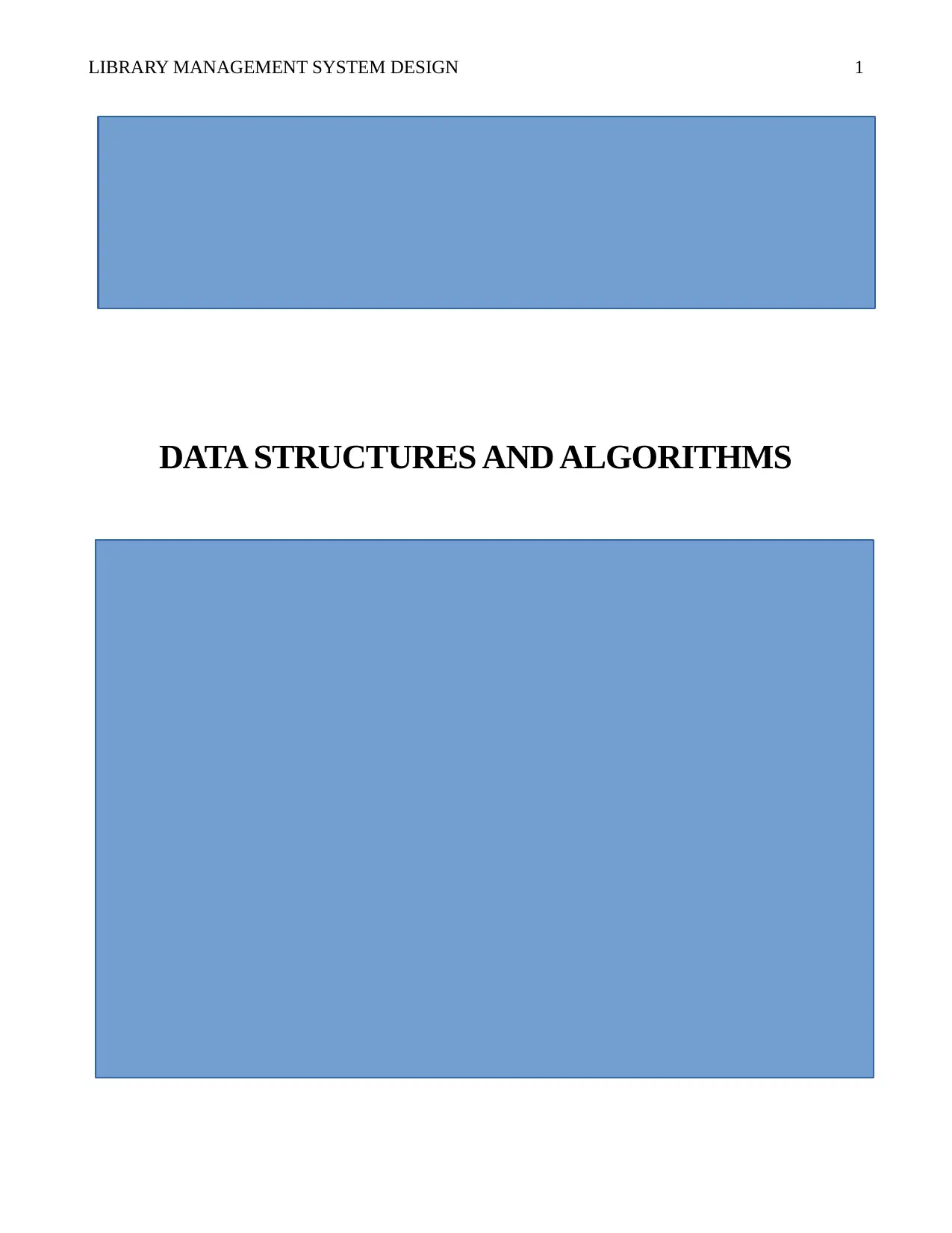
LIBRARY MANAGEMENT SYSTEM DESIGN 1
DATA STRUCTURES AND ALGORITHMS
DATA STRUCTURES AND ALGORITHMS
Paraphrase This Document
Need a fresh take? Get an instant paraphrase of this document with our AI Paraphraser
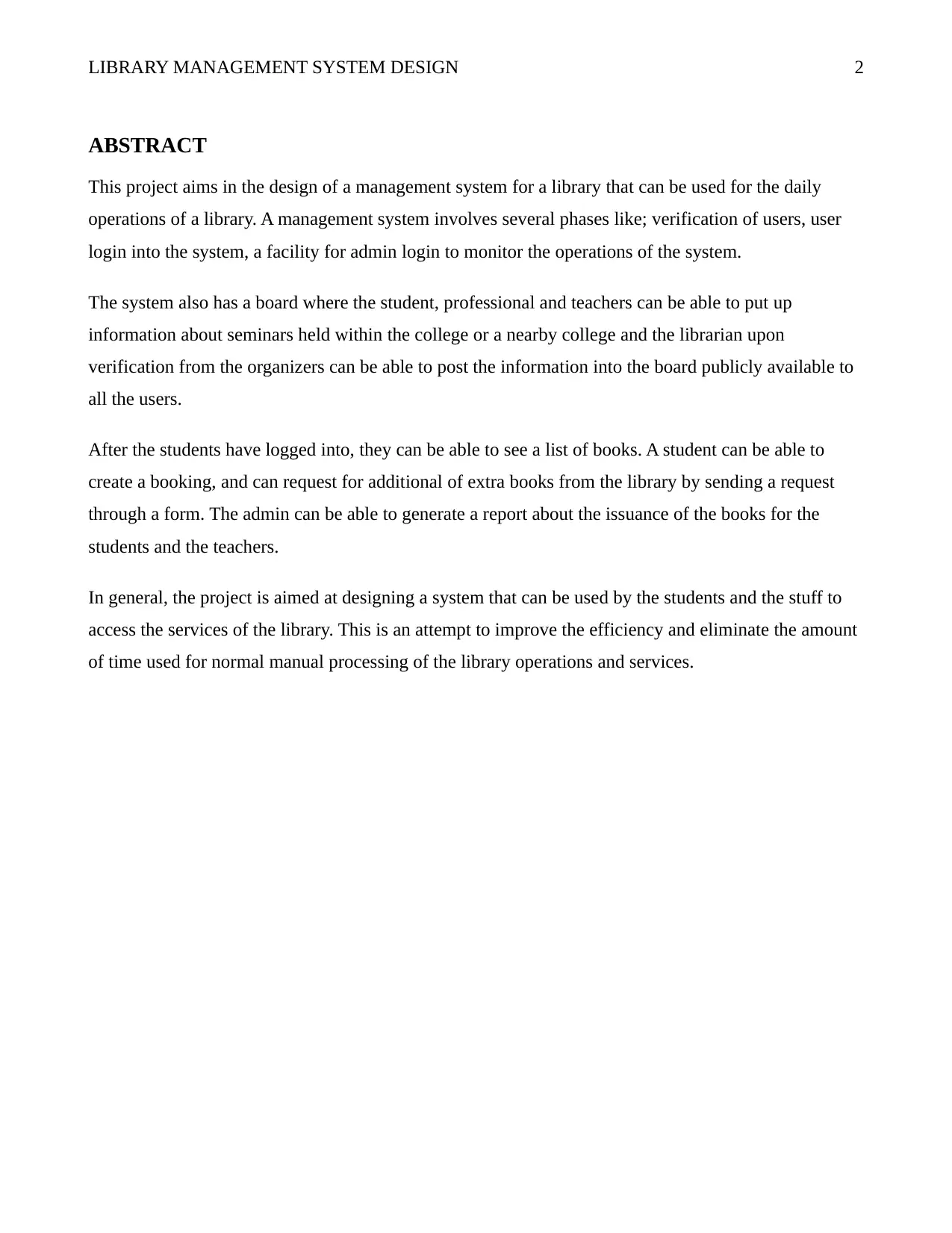
LIBRARY MANAGEMENT SYSTEM DESIGN 2
ABSTRACT
This project aims in the design of a management system for a library that can be used for the daily
operations of a library. A management system involves several phases like; verification of users, user
login into the system, a facility for admin login to monitor the operations of the system.
The system also has a board where the student, professional and teachers can be able to put up
information about seminars held within the college or a nearby college and the librarian upon
verification from the organizers can be able to post the information into the board publicly available to
all the users.
After the students have logged into, they can be able to see a list of books. A student can be able to
create a booking, and can request for additional of extra books from the library by sending a request
through a form. The admin can be able to generate a report about the issuance of the books for the
students and the teachers.
In general, the project is aimed at designing a system that can be used by the students and the stuff to
access the services of the library. This is an attempt to improve the efficiency and eliminate the amount
of time used for normal manual processing of the library operations and services.
ABSTRACT
This project aims in the design of a management system for a library that can be used for the daily
operations of a library. A management system involves several phases like; verification of users, user
login into the system, a facility for admin login to monitor the operations of the system.
The system also has a board where the student, professional and teachers can be able to put up
information about seminars held within the college or a nearby college and the librarian upon
verification from the organizers can be able to post the information into the board publicly available to
all the users.
After the students have logged into, they can be able to see a list of books. A student can be able to
create a booking, and can request for additional of extra books from the library by sending a request
through a form. The admin can be able to generate a report about the issuance of the books for the
students and the teachers.
In general, the project is aimed at designing a system that can be used by the students and the stuff to
access the services of the library. This is an attempt to improve the efficiency and eliminate the amount
of time used for normal manual processing of the library operations and services.
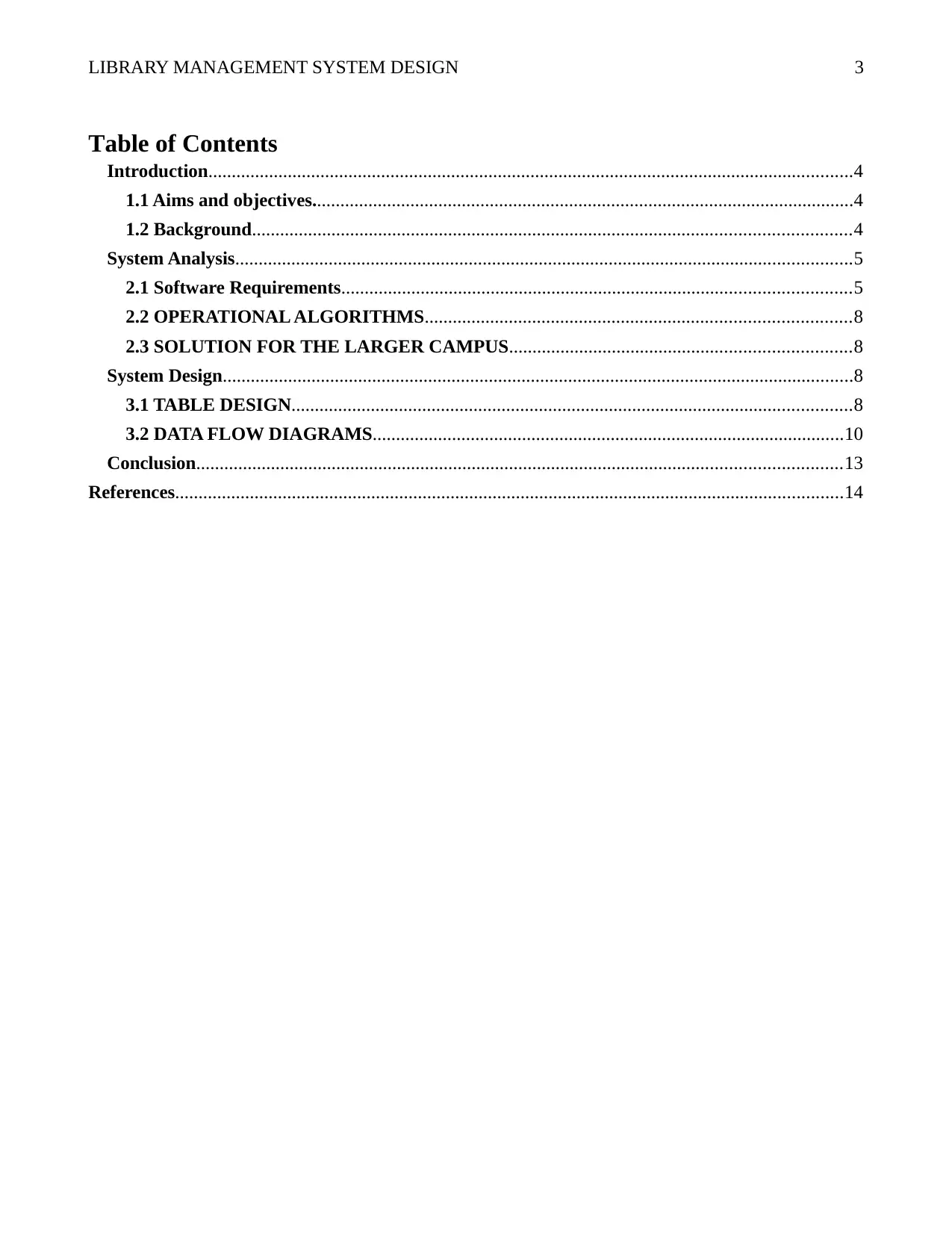
LIBRARY MANAGEMENT SYSTEM DESIGN 3
Table of Contents
Introduction..........................................................................................................................................4
1.1 Aims and objectives....................................................................................................................4
1.2 Background................................................................................................................................4
System Analysis....................................................................................................................................5
2.1 Software Requirements.............................................................................................................5
2.2 OPERATIONAL ALGORITHMS...........................................................................................8
2.3 SOLUTION FOR THE LARGER CAMPUS.........................................................................8
System Design.......................................................................................................................................8
3.1 TABLE DESIGN........................................................................................................................8
3.2 DATA FLOW DIAGRAMS.....................................................................................................10
Conclusion..........................................................................................................................................13
References...............................................................................................................................................14
Table of Contents
Introduction..........................................................................................................................................4
1.1 Aims and objectives....................................................................................................................4
1.2 Background................................................................................................................................4
System Analysis....................................................................................................................................5
2.1 Software Requirements.............................................................................................................5
2.2 OPERATIONAL ALGORITHMS...........................................................................................8
2.3 SOLUTION FOR THE LARGER CAMPUS.........................................................................8
System Design.......................................................................................................................................8
3.1 TABLE DESIGN........................................................................................................................8
3.2 DATA FLOW DIAGRAMS.....................................................................................................10
Conclusion..........................................................................................................................................13
References...............................................................................................................................................14
⊘ This is a preview!⊘
Do you want full access?
Subscribe today to unlock all pages.

Trusted by 1+ million students worldwide
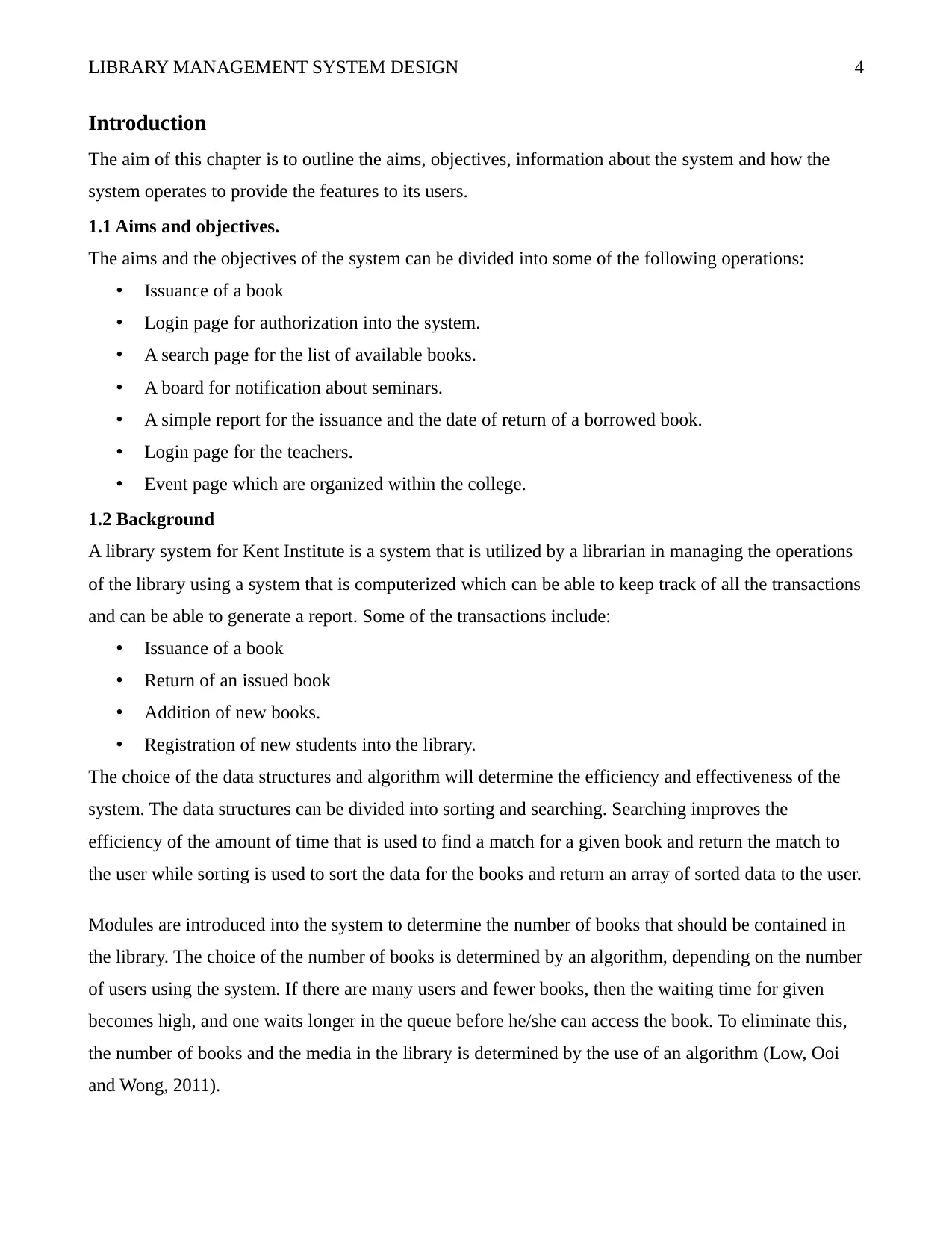
LIBRARY MANAGEMENT SYSTEM DESIGN 4
Introduction
The aim of this chapter is to outline the aims, objectives, information about the system and how the
system operates to provide the features to its users.
1.1 Aims and objectives.
The aims and the objectives of the system can be divided into some of the following operations:
• Issuance of a book
• Login page for authorization into the system.
• A search page for the list of available books.
• A board for notification about seminars.
• A simple report for the issuance and the date of return of a borrowed book.
• Login page for the teachers.
• Event page which are organized within the college.
1.2 Background
A library system for Kent Institute is a system that is utilized by a librarian in managing the operations
of the library using a system that is computerized which can be able to keep track of all the transactions
and can be able to generate a report. Some of the transactions include:
• Issuance of a book
• Return of an issued book
• Addition of new books.
• Registration of new students into the library.
The choice of the data structures and algorithm will determine the efficiency and effectiveness of the
system. The data structures can be divided into sorting and searching. Searching improves the
efficiency of the amount of time that is used to find a match for a given book and return the match to
the user while sorting is used to sort the data for the books and return an array of sorted data to the user.
Modules are introduced into the system to determine the number of books that should be contained in
the library. The choice of the number of books is determined by an algorithm, depending on the number
of users using the system. If there are many users and fewer books, then the waiting time for given
becomes high, and one waits longer in the queue before he/she can access the book. To eliminate this,
the number of books and the media in the library is determined by the use of an algorithm (Low, Ooi
and Wong, 2011).
Introduction
The aim of this chapter is to outline the aims, objectives, information about the system and how the
system operates to provide the features to its users.
1.1 Aims and objectives.
The aims and the objectives of the system can be divided into some of the following operations:
• Issuance of a book
• Login page for authorization into the system.
• A search page for the list of available books.
• A board for notification about seminars.
• A simple report for the issuance and the date of return of a borrowed book.
• Login page for the teachers.
• Event page which are organized within the college.
1.2 Background
A library system for Kent Institute is a system that is utilized by a librarian in managing the operations
of the library using a system that is computerized which can be able to keep track of all the transactions
and can be able to generate a report. Some of the transactions include:
• Issuance of a book
• Return of an issued book
• Addition of new books.
• Registration of new students into the library.
The choice of the data structures and algorithm will determine the efficiency and effectiveness of the
system. The data structures can be divided into sorting and searching. Searching improves the
efficiency of the amount of time that is used to find a match for a given book and return the match to
the user while sorting is used to sort the data for the books and return an array of sorted data to the user.
Modules are introduced into the system to determine the number of books that should be contained in
the library. The choice of the number of books is determined by an algorithm, depending on the number
of users using the system. If there are many users and fewer books, then the waiting time for given
becomes high, and one waits longer in the queue before he/she can access the book. To eliminate this,
the number of books and the media in the library is determined by the use of an algorithm (Low, Ooi
and Wong, 2011).
Paraphrase This Document
Need a fresh take? Get an instant paraphrase of this document with our AI Paraphraser
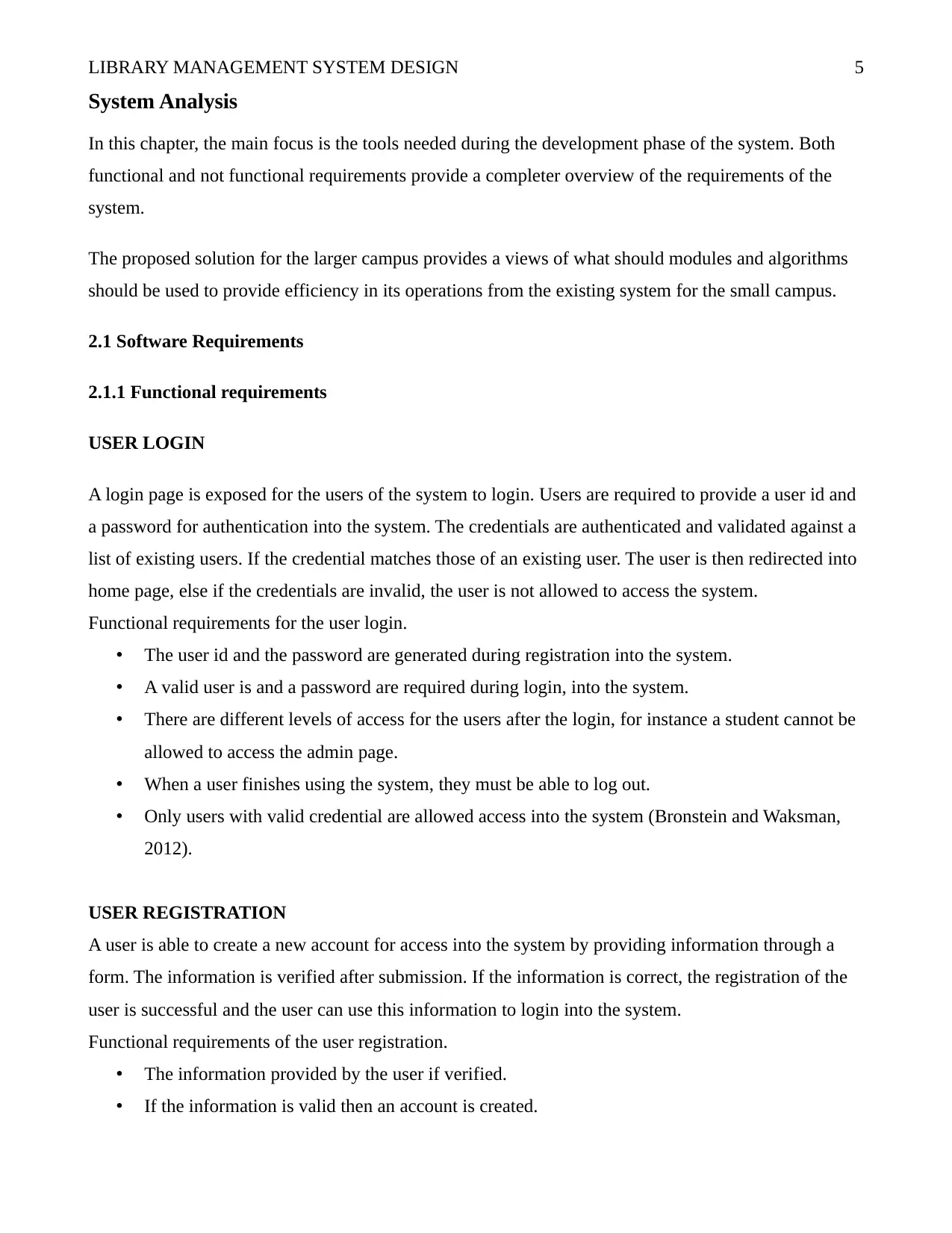
LIBRARY MANAGEMENT SYSTEM DESIGN 5
System Analysis
In this chapter, the main focus is the tools needed during the development phase of the system. Both
functional and not functional requirements provide a completer overview of the requirements of the
system.
The proposed solution for the larger campus provides a views of what should modules and algorithms
should be used to provide efficiency in its operations from the existing system for the small campus.
2.1 Software Requirements
2.1.1 Functional requirements
USER LOGIN
A login page is exposed for the users of the system to login. Users are required to provide a user id and
a password for authentication into the system. The credentials are authenticated and validated against a
list of existing users. If the credential matches those of an existing user. The user is then redirected into
home page, else if the credentials are invalid, the user is not allowed to access the system.
Functional requirements for the user login.
• The user id and the password are generated during registration into the system.
• A valid user is and a password are required during login, into the system.
• There are different levels of access for the users after the login, for instance a student cannot be
allowed to access the admin page.
• When a user finishes using the system, they must be able to log out.
• Only users with valid credential are allowed access into the system (Bronstein and Waksman,
2012).
USER REGISTRATION
A user is able to create a new account for access into the system by providing information through a
form. The information is verified after submission. If the information is correct, the registration of the
user is successful and the user can use this information to login into the system.
Functional requirements of the user registration.
• The information provided by the user if verified.
• If the information is valid then an account is created.
System Analysis
In this chapter, the main focus is the tools needed during the development phase of the system. Both
functional and not functional requirements provide a completer overview of the requirements of the
system.
The proposed solution for the larger campus provides a views of what should modules and algorithms
should be used to provide efficiency in its operations from the existing system for the small campus.
2.1 Software Requirements
2.1.1 Functional requirements
USER LOGIN
A login page is exposed for the users of the system to login. Users are required to provide a user id and
a password for authentication into the system. The credentials are authenticated and validated against a
list of existing users. If the credential matches those of an existing user. The user is then redirected into
home page, else if the credentials are invalid, the user is not allowed to access the system.
Functional requirements for the user login.
• The user id and the password are generated during registration into the system.
• A valid user is and a password are required during login, into the system.
• There are different levels of access for the users after the login, for instance a student cannot be
allowed to access the admin page.
• When a user finishes using the system, they must be able to log out.
• Only users with valid credential are allowed access into the system (Bronstein and Waksman,
2012).
USER REGISTRATION
A user is able to create a new account for access into the system by providing information through a
form. The information is verified after submission. If the information is correct, the registration of the
user is successful and the user can use this information to login into the system.
Functional requirements of the user registration.
• The information provided by the user if verified.
• If the information is valid then an account is created.
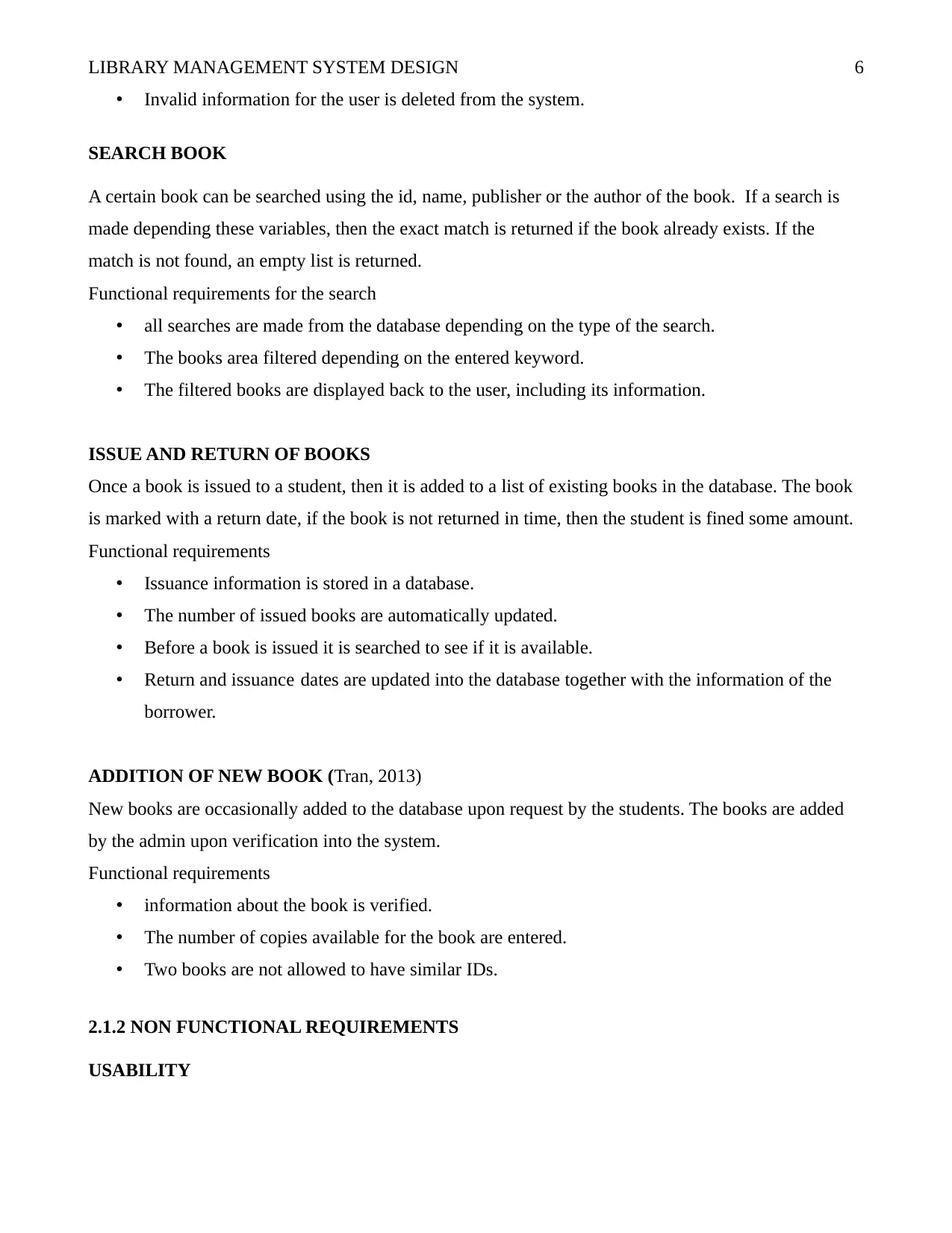
LIBRARY MANAGEMENT SYSTEM DESIGN 6
• Invalid information for the user is deleted from the system.
SEARCH BOOK
A certain book can be searched using the id, name, publisher or the author of the book. If a search is
made depending these variables, then the exact match is returned if the book already exists. If the
match is not found, an empty list is returned.
Functional requirements for the search
• all searches are made from the database depending on the type of the search.
• The books area filtered depending on the entered keyword.
• The filtered books are displayed back to the user, including its information.
ISSUE AND RETURN OF BOOKS
Once a book is issued to a student, then it is added to a list of existing books in the database. The book
is marked with a return date, if the book is not returned in time, then the student is fined some amount.
Functional requirements
• Issuance information is stored in a database.
• The number of issued books are automatically updated.
• Before a book is issued it is searched to see if it is available.
• Return and issuance dates are updated into the database together with the information of the
borrower.
ADDITION OF NEW BOOK (Tran, 2013)
New books are occasionally added to the database upon request by the students. The books are added
by the admin upon verification into the system.
Functional requirements
• information about the book is verified.
• The number of copies available for the book are entered.
• Two books are not allowed to have similar IDs.
2.1.2 NON FUNCTIONAL REQUIREMENTS
USABILITY
• Invalid information for the user is deleted from the system.
SEARCH BOOK
A certain book can be searched using the id, name, publisher or the author of the book. If a search is
made depending these variables, then the exact match is returned if the book already exists. If the
match is not found, an empty list is returned.
Functional requirements for the search
• all searches are made from the database depending on the type of the search.
• The books area filtered depending on the entered keyword.
• The filtered books are displayed back to the user, including its information.
ISSUE AND RETURN OF BOOKS
Once a book is issued to a student, then it is added to a list of existing books in the database. The book
is marked with a return date, if the book is not returned in time, then the student is fined some amount.
Functional requirements
• Issuance information is stored in a database.
• The number of issued books are automatically updated.
• Before a book is issued it is searched to see if it is available.
• Return and issuance dates are updated into the database together with the information of the
borrower.
ADDITION OF NEW BOOK (Tran, 2013)
New books are occasionally added to the database upon request by the students. The books are added
by the admin upon verification into the system.
Functional requirements
• information about the book is verified.
• The number of copies available for the book are entered.
• Two books are not allowed to have similar IDs.
2.1.2 NON FUNCTIONAL REQUIREMENTS
USABILITY
⊘ This is a preview!⊘
Do you want full access?
Subscribe today to unlock all pages.

Trusted by 1+ million students worldwide
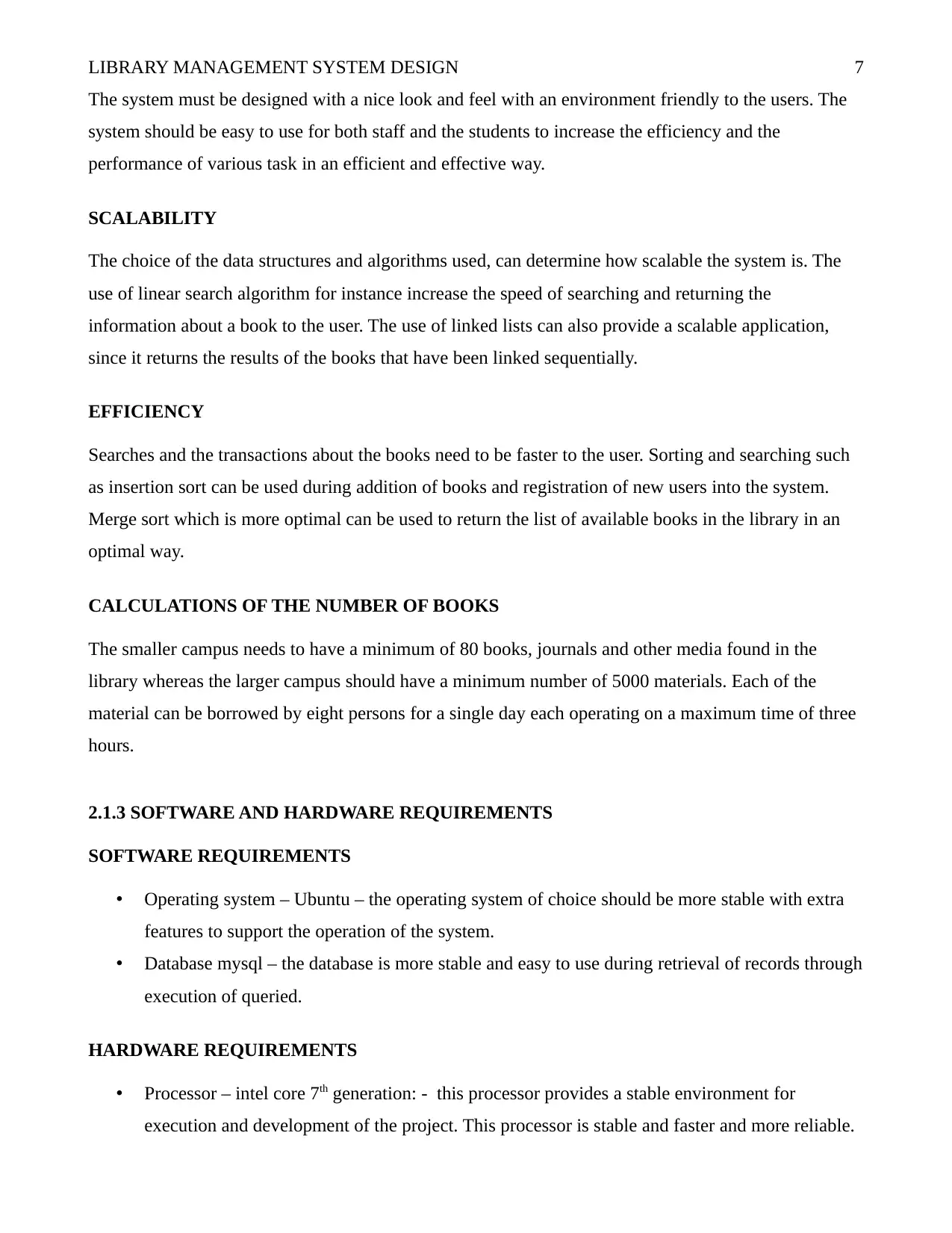
LIBRARY MANAGEMENT SYSTEM DESIGN 7
The system must be designed with a nice look and feel with an environment friendly to the users. The
system should be easy to use for both staff and the students to increase the efficiency and the
performance of various task in an efficient and effective way.
SCALABILITY
The choice of the data structures and algorithms used, can determine how scalable the system is. The
use of linear search algorithm for instance increase the speed of searching and returning the
information about a book to the user. The use of linked lists can also provide a scalable application,
since it returns the results of the books that have been linked sequentially.
EFFICIENCY
Searches and the transactions about the books need to be faster to the user. Sorting and searching such
as insertion sort can be used during addition of books and registration of new users into the system.
Merge sort which is more optimal can be used to return the list of available books in the library in an
optimal way.
CALCULATIONS OF THE NUMBER OF BOOKS
The smaller campus needs to have a minimum of 80 books, journals and other media found in the
library whereas the larger campus should have a minimum number of 5000 materials. Each of the
material can be borrowed by eight persons for a single day each operating on a maximum time of three
hours.
2.1.3 SOFTWARE AND HARDWARE REQUIREMENTS
SOFTWARE REQUIREMENTS
• Operating system – Ubuntu – the operating system of choice should be more stable with extra
features to support the operation of the system.
• Database mysql – the database is more stable and easy to use during retrieval of records through
execution of queried.
HARDWARE REQUIREMENTS
• Processor – intel core 7th generation: - this processor provides a stable environment for
execution and development of the project. This processor is stable and faster and more reliable.
The system must be designed with a nice look and feel with an environment friendly to the users. The
system should be easy to use for both staff and the students to increase the efficiency and the
performance of various task in an efficient and effective way.
SCALABILITY
The choice of the data structures and algorithms used, can determine how scalable the system is. The
use of linear search algorithm for instance increase the speed of searching and returning the
information about a book to the user. The use of linked lists can also provide a scalable application,
since it returns the results of the books that have been linked sequentially.
EFFICIENCY
Searches and the transactions about the books need to be faster to the user. Sorting and searching such
as insertion sort can be used during addition of books and registration of new users into the system.
Merge sort which is more optimal can be used to return the list of available books in the library in an
optimal way.
CALCULATIONS OF THE NUMBER OF BOOKS
The smaller campus needs to have a minimum of 80 books, journals and other media found in the
library whereas the larger campus should have a minimum number of 5000 materials. Each of the
material can be borrowed by eight persons for a single day each operating on a maximum time of three
hours.
2.1.3 SOFTWARE AND HARDWARE REQUIREMENTS
SOFTWARE REQUIREMENTS
• Operating system – Ubuntu – the operating system of choice should be more stable with extra
features to support the operation of the system.
• Database mysql – the database is more stable and easy to use during retrieval of records through
execution of queried.
HARDWARE REQUIREMENTS
• Processor – intel core 7th generation: - this processor provides a stable environment for
execution and development of the project. This processor is stable and faster and more reliable.
Paraphrase This Document
Need a fresh take? Get an instant paraphrase of this document with our AI Paraphraser
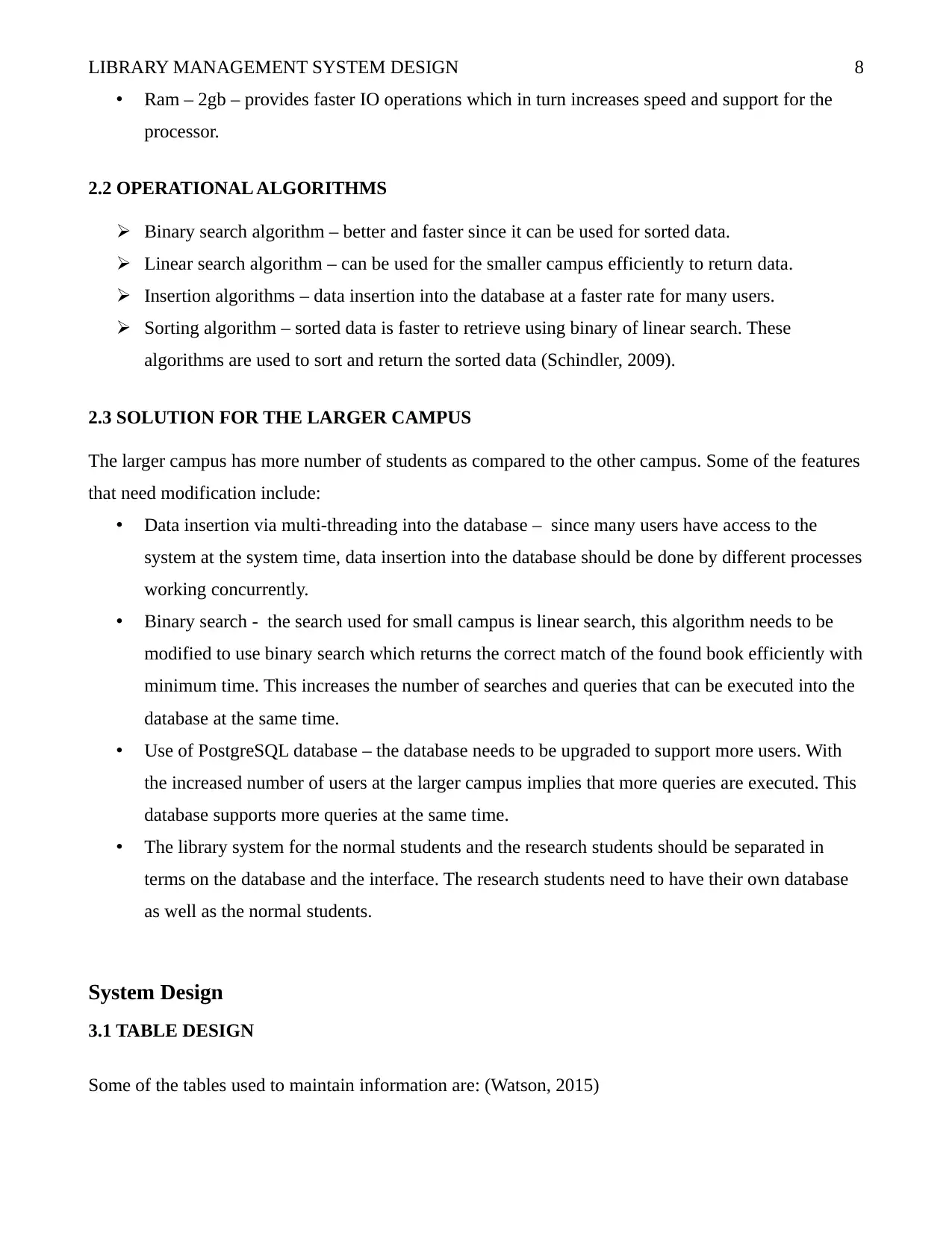
LIBRARY MANAGEMENT SYSTEM DESIGN 8
• Ram – 2gb – provides faster IO operations which in turn increases speed and support for the
processor.
2.2 OPERATIONAL ALGORITHMS
➢ Binary search algorithm – better and faster since it can be used for sorted data.
➢ Linear search algorithm – can be used for the smaller campus efficiently to return data.
➢ Insertion algorithms – data insertion into the database at a faster rate for many users.
➢ Sorting algorithm – sorted data is faster to retrieve using binary of linear search. These
algorithms are used to sort and return the sorted data (Schindler, 2009).
2.3 SOLUTION FOR THE LARGER CAMPUS
The larger campus has more number of students as compared to the other campus. Some of the features
that need modification include:
• Data insertion via multi-threading into the database – since many users have access to the
system at the system time, data insertion into the database should be done by different processes
working concurrently.
• Binary search - the search used for small campus is linear search, this algorithm needs to be
modified to use binary search which returns the correct match of the found book efficiently with
minimum time. This increases the number of searches and queries that can be executed into the
database at the same time.
• Use of PostgreSQL database – the database needs to be upgraded to support more users. With
the increased number of users at the larger campus implies that more queries are executed. This
database supports more queries at the same time.
• The library system for the normal students and the research students should be separated in
terms on the database and the interface. The research students need to have their own database
as well as the normal students.
System Design
3.1 TABLE DESIGN
Some of the tables used to maintain information are: (Watson, 2015)
• Ram – 2gb – provides faster IO operations which in turn increases speed and support for the
processor.
2.2 OPERATIONAL ALGORITHMS
➢ Binary search algorithm – better and faster since it can be used for sorted data.
➢ Linear search algorithm – can be used for the smaller campus efficiently to return data.
➢ Insertion algorithms – data insertion into the database at a faster rate for many users.
➢ Sorting algorithm – sorted data is faster to retrieve using binary of linear search. These
algorithms are used to sort and return the sorted data (Schindler, 2009).
2.3 SOLUTION FOR THE LARGER CAMPUS
The larger campus has more number of students as compared to the other campus. Some of the features
that need modification include:
• Data insertion via multi-threading into the database – since many users have access to the
system at the system time, data insertion into the database should be done by different processes
working concurrently.
• Binary search - the search used for small campus is linear search, this algorithm needs to be
modified to use binary search which returns the correct match of the found book efficiently with
minimum time. This increases the number of searches and queries that can be executed into the
database at the same time.
• Use of PostgreSQL database – the database needs to be upgraded to support more users. With
the increased number of users at the larger campus implies that more queries are executed. This
database supports more queries at the same time.
• The library system for the normal students and the research students should be separated in
terms on the database and the interface. The research students need to have their own database
as well as the normal students.
System Design
3.1 TABLE DESIGN
Some of the tables used to maintain information are: (Watson, 2015)
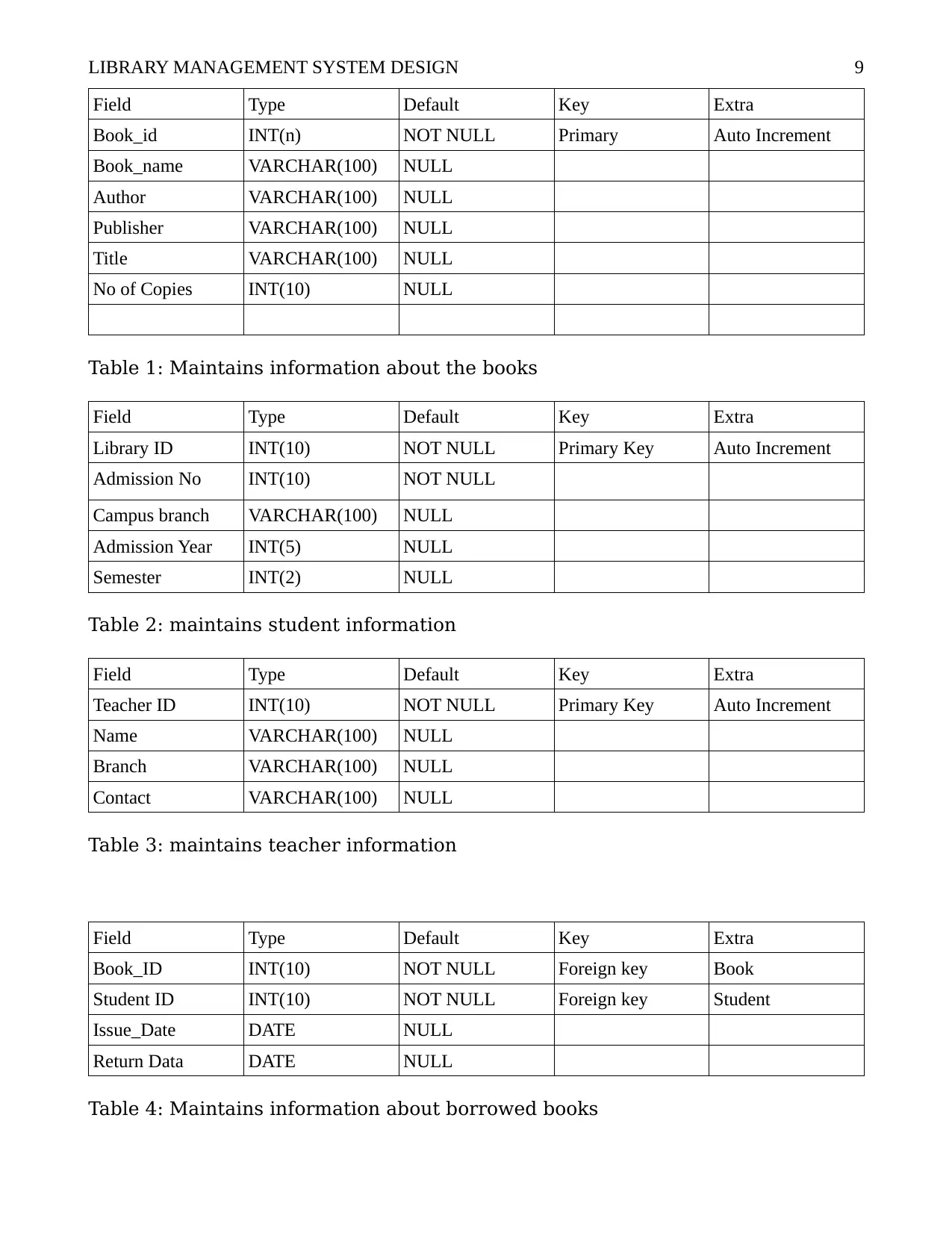
LIBRARY MANAGEMENT SYSTEM DESIGN 9
Field Type Default Key Extra
Book_id INT(n) NOT NULL Primary Auto Increment
Book_name VARCHAR(100) NULL
Author VARCHAR(100) NULL
Publisher VARCHAR(100) NULL
Title VARCHAR(100) NULL
No of Copies INT(10) NULL
Table 1: Maintains information about the books
Field Type Default Key Extra
Library ID INT(10) NOT NULL Primary Key Auto Increment
Admission No INT(10) NOT NULL
Campus branch VARCHAR(100) NULL
Admission Year INT(5) NULL
Semester INT(2) NULL
Table 2: maintains student information
Field Type Default Key Extra
Teacher ID INT(10) NOT NULL Primary Key Auto Increment
Name VARCHAR(100) NULL
Branch VARCHAR(100) NULL
Contact VARCHAR(100) NULL
Table 3: maintains teacher information
Field Type Default Key Extra
Book_ID INT(10) NOT NULL Foreign key Book
Student ID INT(10) NOT NULL Foreign key Student
Issue_Date DATE NULL
Return Data DATE NULL
Table 4: Maintains information about borrowed books
Field Type Default Key Extra
Book_id INT(n) NOT NULL Primary Auto Increment
Book_name VARCHAR(100) NULL
Author VARCHAR(100) NULL
Publisher VARCHAR(100) NULL
Title VARCHAR(100) NULL
No of Copies INT(10) NULL
Table 1: Maintains information about the books
Field Type Default Key Extra
Library ID INT(10) NOT NULL Primary Key Auto Increment
Admission No INT(10) NOT NULL
Campus branch VARCHAR(100) NULL
Admission Year INT(5) NULL
Semester INT(2) NULL
Table 2: maintains student information
Field Type Default Key Extra
Teacher ID INT(10) NOT NULL Primary Key Auto Increment
Name VARCHAR(100) NULL
Branch VARCHAR(100) NULL
Contact VARCHAR(100) NULL
Table 3: maintains teacher information
Field Type Default Key Extra
Book_ID INT(10) NOT NULL Foreign key Book
Student ID INT(10) NOT NULL Foreign key Student
Issue_Date DATE NULL
Return Data DATE NULL
Table 4: Maintains information about borrowed books
⊘ This is a preview!⊘
Do you want full access?
Subscribe today to unlock all pages.

Trusted by 1+ million students worldwide
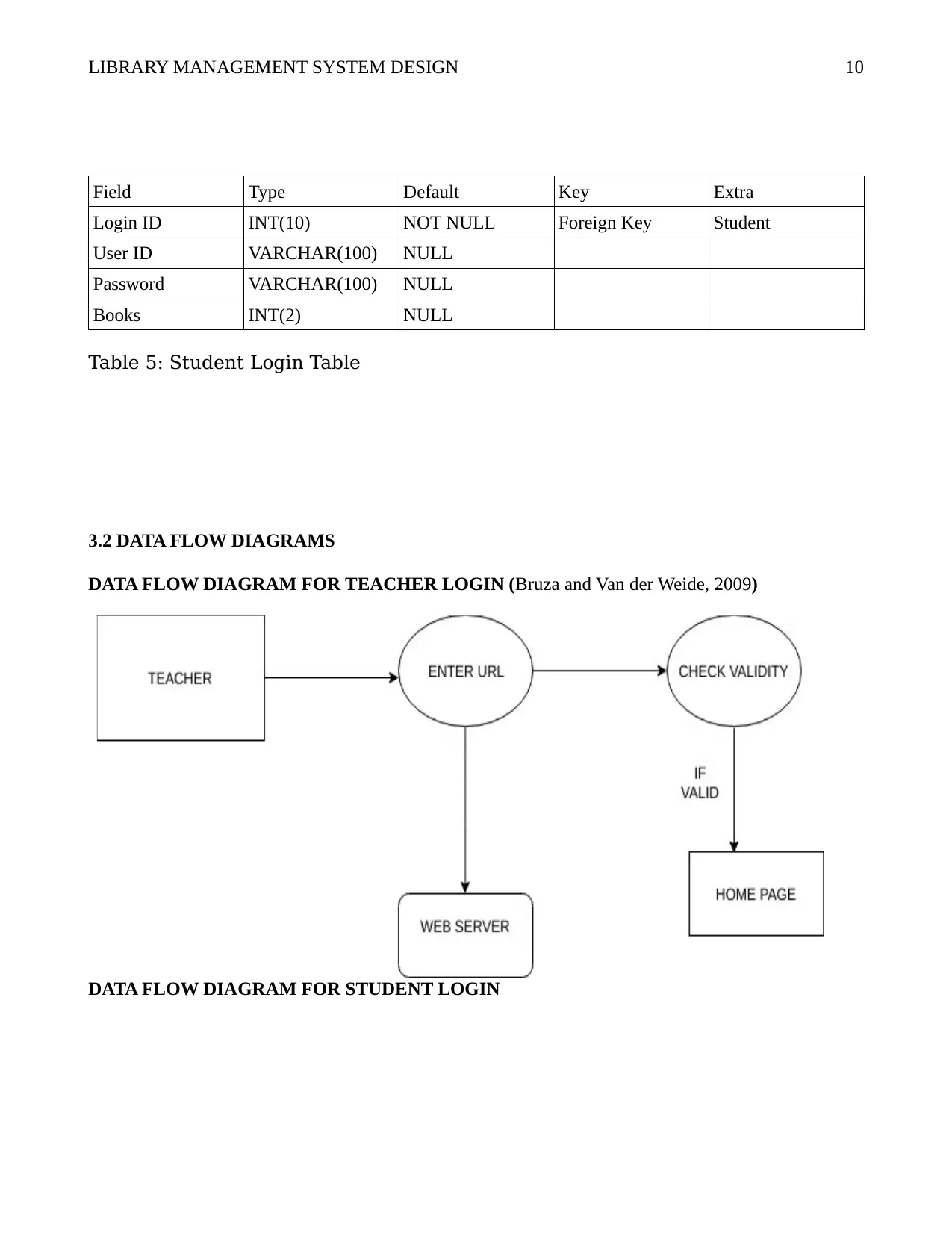
LIBRARY MANAGEMENT SYSTEM DESIGN 10
Field Type Default Key Extra
Login ID INT(10) NOT NULL Foreign Key Student
User ID VARCHAR(100) NULL
Password VARCHAR(100) NULL
Books INT(2) NULL
Table 5: Student Login Table
3.2 DATA FLOW DIAGRAMS
DATA FLOW DIAGRAM FOR TEACHER LOGIN (Bruza and Van der Weide, 2009)
DATA FLOW DIAGRAM FOR STUDENT LOGIN
Field Type Default Key Extra
Login ID INT(10) NOT NULL Foreign Key Student
User ID VARCHAR(100) NULL
Password VARCHAR(100) NULL
Books INT(2) NULL
Table 5: Student Login Table
3.2 DATA FLOW DIAGRAMS
DATA FLOW DIAGRAM FOR TEACHER LOGIN (Bruza and Van der Weide, 2009)
DATA FLOW DIAGRAM FOR STUDENT LOGIN
Paraphrase This Document
Need a fresh take? Get an instant paraphrase of this document with our AI Paraphraser
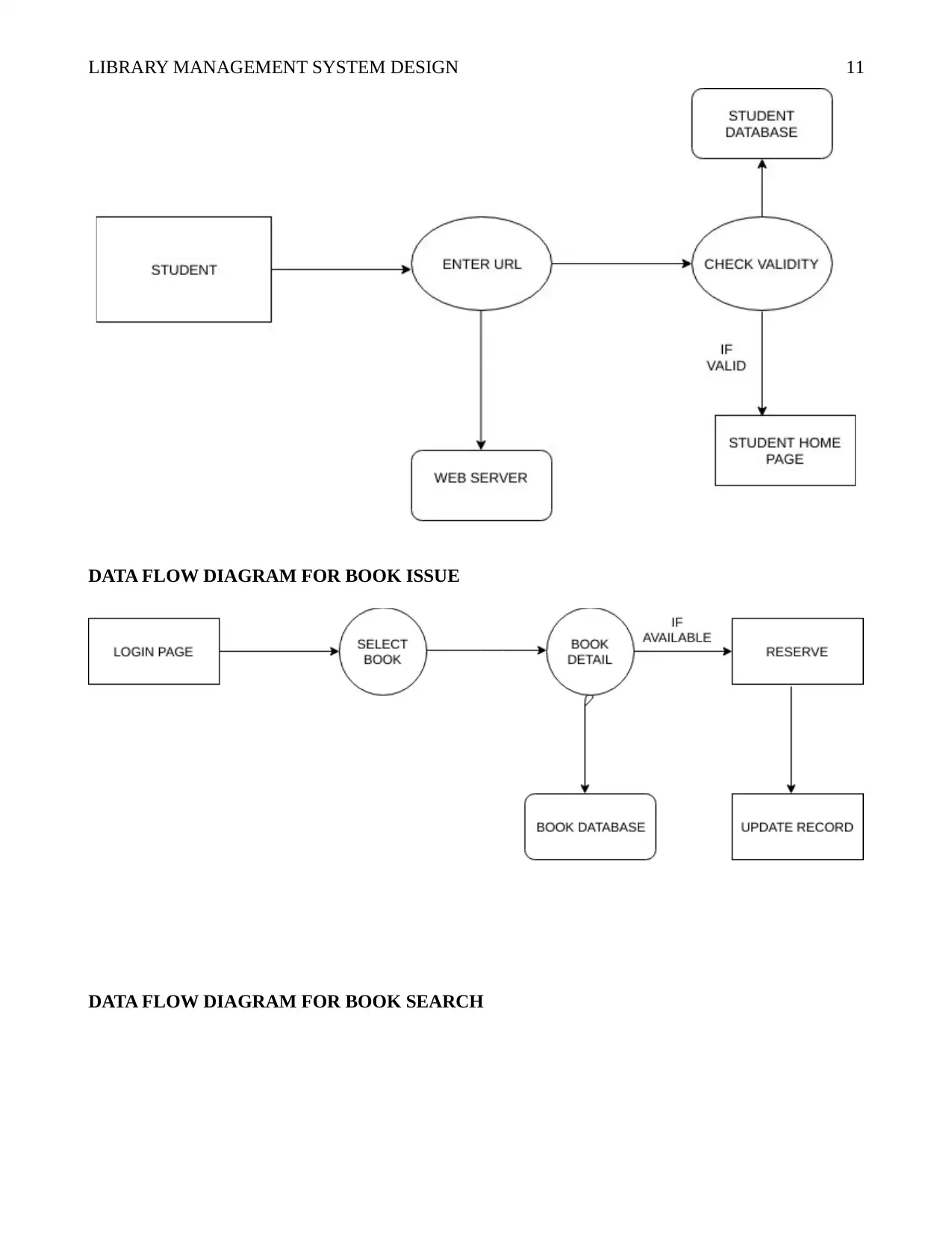
LIBRARY MANAGEMENT SYSTEM DESIGN 11
DATA FLOW DIAGRAM FOR BOOK ISSUE
DATA FLOW DIAGRAM FOR BOOK SEARCH
DATA FLOW DIAGRAM FOR BOOK ISSUE
DATA FLOW DIAGRAM FOR BOOK SEARCH
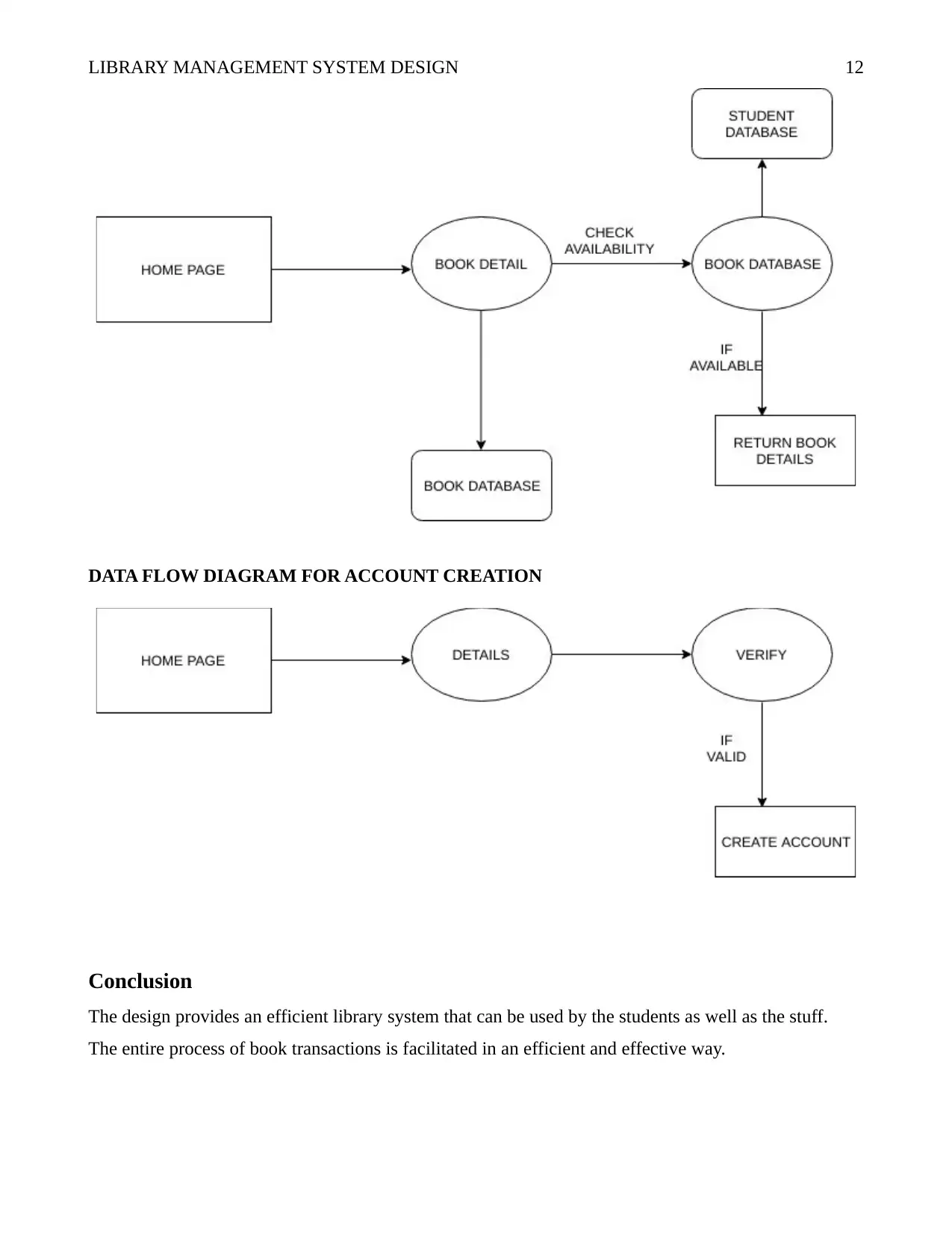
LIBRARY MANAGEMENT SYSTEM DESIGN 12
DATA FLOW DIAGRAM FOR ACCOUNT CREATION
Conclusion
The design provides an efficient library system that can be used by the students as well as the stuff.
The entire process of book transactions is facilitated in an efficient and effective way.
DATA FLOW DIAGRAM FOR ACCOUNT CREATION
Conclusion
The design provides an efficient library system that can be used by the students as well as the stuff.
The entire process of book transactions is facilitated in an efficient and effective way.
⊘ This is a preview!⊘
Do you want full access?
Subscribe today to unlock all pages.

Trusted by 1+ million students worldwide
1 out of 14
Related Documents
Your All-in-One AI-Powered Toolkit for Academic Success.
+13062052269
info@desklib.com
Available 24*7 on WhatsApp / Email
![[object Object]](/_next/static/media/star-bottom.7253800d.svg)
Unlock your academic potential
Copyright © 2020–2025 A2Z Services. All Rights Reserved. Developed and managed by ZUCOL.





